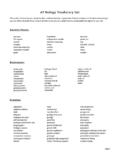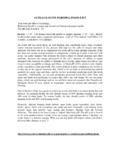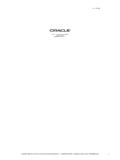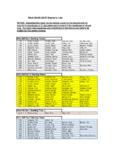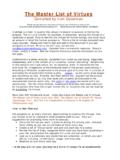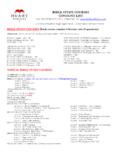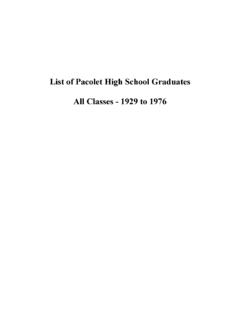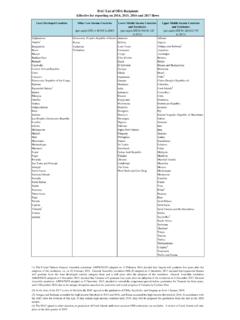Transcription of 1 Model List of Essential Medicines (April
1 Annex 1 19th WHO Model List of Essential Medicines (April 2015) Explanatory notes The core list presents a list of minimum medicine needs for a basic health care system, listing the most efficacious, safe and cost effective Medicines for priority conditions. Priority conditions are selected on the basis of current and estimated future public health relevance, and potential for safe and cost effective treatment. The complementary list presents Essential Medicines for priority diseases, for which specialized diagnostic or monitoring facilities, and/or specialist medical care, and/or specialist training are needed. In case of doubt Medicines may also be listed as complementary on the basis of consistent higher costs or less attractive cost effectiveness in a variety of settings. The square box symbol ( ) is primarily intended to indicate similar clinical performance within a pharmacological class. The listed medicine should be the example of the class for which there is the best evidence for effectiveness and safety.
2 In some cases, this may be the first medicine that is licensed for marketing; in other instances, subsequently licensed compounds may be safer or more effective. Where there is no difference in terms of efficacy and safety data, the listed medicine should be the one that is generally available at the lowest price, based on international drug price information sources. Not all square boxes are applicable to medicine selection for children see the second EMLc for details. Therapeutic equivalence is indicated only on the basis of reviews of efficacy and safety and when consistent with WHO clinical guidelines. National lists should not use a similar symbol and should be specific in their final selection, which would depend on local availability and price. The a symbol indicates that there is an age or weight restriction on use of the medicine ; details for each medicine can be found in Table Where the [c] symbol is placed next to the complementary list it signifies that the medicine (s) require(s) specialist diagnostic or monitoring facilities, and/or specialist medical care, and/or specialist training for their use in children.
3 Where the [c] symbol is placed next to an individual medicine or strength of medicine it signifies that there is a specific indication for restricting its use to children. The presence of an entry on the Essential Medicines List carries no assurance as to pharmaceutical quality. It is the responsibility of the relevant national or regional drug regulatory authority to ensure that each product is of appropriate pharmaceutical quality (including stability) and that, when relevant, different products are interchangeable. For recommendations and advice concerning all aspects of the quality assurance of Medicines see the WHO Medicines website Medicines and dosage forms are listed in alphabetical order within each section and there is no implication of preference for one form over another. Standard treatment guidelines should be consulted for information on appropriate dosage forms. The main terms used for dosage forms in the Essential Medicines List can be found in Table Definitions of many of these terms and pharmaceutical quality requirements applicable to the different categories are published in the current edition of The International Pharmacopoeia Essential Medicines 19th edition WHO Model List 19th WHO Model List of Essential Medicines (April 2015) page - 1 1.
4 ANAESTHETICS General anaesthetics and oxygen Inhalational Medicines halothane oxide Inhalation(medicinal gas). Injectable Medicines ketamine Injection: 50mg (as hydrochloride)/mL in 10 mL vial. propofol* Injection: 10mg/mL; 20mg/mL.* Thiopental may be used as an alternative depending on local availability and cost. Local anaesthetics bupivacaine ; (hydrochloride) in vial. Injection for spinal anaesthesia: (hydrochloride) in 4 mL ampoule to be mixed with glucose solution. lidocaine Injection:1%; 2% (hydrochloride) in vial. Injection for spinal anaesthesia: 5% (hydrochloride) in 2 mL ampoule to be mixed with glucose solution. Topical forms: 2% to 4% (hydrochloride). lidocaine + epinephrine (adrenaline) Dental cartridge:2% (hydrochloride) + epinephrine 1:80 : 1%; 2% (hydrochloride or sulfate) + epinephrine 1:200 000 in vial. Complementary List ephedrine Injection: 30 mg (hydrochloride)/ mL in 1 mL ampoule. (For use in spinal anaesthesia during delivery, to prevent hypotension).
5 Preoperative medication and sedation for short-term procedures atropine Injection:1 mg (sulfate) in 1 mLampoule. midazolam Injection:1 liquid: 2 mg/ mL [c]. Tablet: mg; 15 mg. morphine Injection:10 mg (sulfateor hydrochloride) in 1 mL Medicines 19th edition WHO Model List 19th WHO Model List of Essential Medicines (April 2015) page - 2 2. Medicines FOR PAIN AND PALLIATIVE CARE Non-opioids and non-steroidal anti-inflammatory Medicines (NSAIMs) acetylsalicylic acid Suppository:50 mg to 150 mg. Tablet: 100 mg to 500 mg. ibuprofen a Oral liquid:200 mg/5 : 200 mg; 400 mg; 600 mg. a Not in children less than 3 months. paracetamol* Oral liquid:125 : 100 mg. Tablet: 100 mg to 500 mg. * Not recommended for anti inflammatory use due to lack of proven benefit to that effect. Opioid analgesics codeine Tablet:30 mg (phosphate). morphine* Granules (slow release; to mix with water):20 mg 200 mg (morphine sulfate). Injection: 10 mg (morphine hydrochloride or morphine sulfate) in 1 mL ampoule.
6 Oral liquid: 10 mg (morphine hydrochloride or morphine sulfate)/5 mL. Tablet (slow release): 10 mg 200mg (morphine hydrochloride or morphine sulfate). Tablet (immediate release): 10 mg (morphine sulfate). *Alternatives limited to hydromorphone and oxycodone Medicines for other common symptoms in palliative care amitriptyline Tablet: 10 mg; 25 mg; 75 mg. cyclizine [c] Injection: 50 : 50 mg. dexamethasone Injection: 4 mg/mLin 1 mL ampoule (as disodium phosphate salt). Oral liquid: 2 mg/5 mL. Tablet: 2 mg [c]; 4 mg. Essential Medicines 19th edition WHO Model List 19th WHO Model List of Essential Medicines (April 2015) page - 3 diazepam Injection: 5 liquid: 2 mg/5 mL. Rectal solution: mg; 5 mg; 10 mg. Tablet: 5 mg; 10 mg. docusate sodium Capsule: 100 mg. Oral liquid: 50 mg/5 mL. fluoxetine a Solid oral dosage form:20 mg (as hydrochloride).a >8 years. haloperidol Injection:5 mg in 1 mLampoule. Oral liquid: 2 mg/ mL. Solid oral dosage form: mg; 2mg; 5 mg.
7 Hyoscine butylbromide Injection: 20 mg/ mL. hyoscine hydrobromide [c] Injection: 400 micrograms/mL; 600 micrograms/mL. Transdermal patches: 1 mg/72 hours. lactulose [c] Oral liquid: g/5 mL. loperamide Solid oral dosage form: 2 mg. metoclopramide Injection: 5 mg(hydrochloride)/mL in 2 mL ampoule. Oral liquid: 5 mg/5 mL. Solid oral form: 10 mg (hydrochloride). midazolam Injection: 1mg/mL; 5mg/mL. Solid oral dosage form: mg; 15 mg. Oral liquid: 2mg/ mL [c]. ondansetron [c] a Injection: 2 mg base/mLin 2 mL ampoule (as hydrochloride). Oral liquid: 4 mg base/5 mL. Solid oral dosage form: Eq 4 mg base; Eq 8 mg base. a >1 month. senna Oral liquid: mg/5 mL. 3. ANTIALLERGICS AND Medicines USED IN ANAPHYLAXIS dexamethasone Injection: 4 mg/mLin 1 mL ampoule (as disodium phosphate salt). epinephrine (adrenaline) Injection:1 mg (as hydrochloride or hydrogen tartrate) in 1 mL ampoule. hydrocortisone Powder for injection:100 mg (as sodium succinate) in vial.
8 Essential Medicines 19th edition WHO Model List 19th WHO Model List of Essential Medicines (April 2015) page - 4 loratadine * Oral liquid: 1 : 10 mg. *There may be a role for sedating antihistamines for limited indications (EMLc). prednisolone Oral liquid:5mg/mL[c].Tablet: 5 mg; 25 mg. 4. ANTIDOTES AND OTHER SUBSTANCES USED IN POISONINGS Non-specific charcoal, activated Specific acetylcysteine Injection:200 mg/mLin 10 mL ampoule. Oral liquid: 10% [c]; 20% [c]. atropine Injection:1 mg (sulfate) in 1 mL ampoule. calcium gluconate Injection:100 mg/mLin 10 mL ampoule. methylthioninium chloride (methylene blue) Injection: 10 mg/ mL in 10 mL ampoule. naloxone Injection:400 micrograms (hydrochloride) in 1 mLampoule. penicillamine Solid oral dosage form:250 mg. potassium ferric hexacyano ferrate(II) 2H2O(Prussian blue) Powder for oral administration. sodium nitrite Injection:30 mg/mLin 10 mL ampoule. sodium thiosulfate Injection:250 mg/mLin 50 mL ampoule.
9 Complementary List deferoxamine Powder for injection: 500 mg (mesilate) in vial. dimercaprol Injection in oil: 50 mg/ mL in 2 mL ampoule. fomepizole Injection: 5 mg/ mL (sulfate) in 20 mL ampoule or 1 g/ mL (base) in mL ampoule. sodium calcium edetate Injection: 200 mg/ mL in 5 mL ampoule. succimer Solid oral dosage form: 100 mg. 5. ANTICONVULSANTS/ANTIEPILEPTICS carbamazepine Oral liquid:100 mg/5 (chewable): 100 mg; 200 mg. Tablet (scored): 100 mg; 200 mg. diazepam Gel or rectal solution: 5mg/ mL in mL; 2 mL;4 mL tubes. Essential Medicines 19th edition WHO Model List 19th WHO Model List of Essential Medicines (April 2015) page - 5 lorazepam Parenteral formulation: 2 mg/ mL in 1 mL ampoule; 4 mg/ mL in 1 mL ampoule. magnesium sulfate* 2 mL ampoule (equivalent to 1 g in 2 mL; 50% weight/volume); mL in 10 mL ampoule (equivalent to 5 g in 10 mL; 50% weight/volume). * For use in eclampsia and severe pre eclampsia and not for other convulsant disorders.
10 Midazolam Solution for oromucosal administration: 5 mg/mL;10 mg/mL Ampoule*: 1 mg/ mL; 10 mg/mL *for buccal administration when solution for oromucosal administration is not available phenobarbital Injection: 200 mg/mL(sodium). Oral liquid: 15 mg/5 mL. Tablet: 15 mg to 100 mg. phenytoin Injection:50 mg/mLin 5 mL vial (sodium salt).Oral liquid: 25 mg to 30 mg/5 mL.* Solid oral dosage form: 25 mg; 50 mg; 100 mg (sodium salt). Tablet (chewable): 50 mg. * The presence of both 25 mg/5 mL and 30 mg/5 mL strengths on the same market would cause confusion in prescribing and dispensing and should be avoided. valproic acid (sodium valproate) Oral liquid:200 mg/5 (crushable): 100 mg. Tablet (enteric coated): 200 mg; 500 mg (sodium valproate). Complementary List ethosuximide Capsule: 250 mg. Oral liquid: 250 mg/5 mL. valproic acid (sodium valproate) Injection: 100 mg/ mL in 4 mL ampoule; 100 mg/ mL in 10 mL ampoule. 6. ANTI-INFECTIVE Medicines Anthelminthics Intestinal anthelminthics albendazole Tablet (chewable):400 Medicines 19th edition WHO Model List 19th WHO Model List of Essential Medicines (April 2015) page - 6 levamisole Tablet:50 mg; 150 mg (as hydrochloride).










